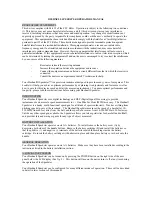
Houston Radar PD420 User Manual
Page 37 of 46
Appendix A: Using trigger outputs
The radars feature six low impedance “open drain” outputs that can trigger/turn on an
external device when a vehicle is detected in a combination of user defined lanes. When a
vehicle is detected in a lane and this lane is mapped to a trigger output, that output is
pulled down to GND and held low as long as a vehicle is tracked in that lane. The output
is released when the radar detects no further targets in that lane. The logic may be
inverted via a bit in the IO variable. The signal duration may be extended by
programming HT variable. Both of these variables may be set directly or via the supplied
configuration GUI.
The outputs are of “open drain” type and are capable of sinking 150 mA each and are
rated at 28V. They may be connected in parallel to double the current sink capacity.
Device that provides this functionality is the ON-Semi “NUD3124” relay driver. Please
refer to the
datasheet
for this device on detailed operating characteristics. For a quick
reference, the internal diagram of this device from the On Semi datasheet is shown
below.
The six outputs O/P1 through O/P6 are brought out on the radar connector pins. See
IO
connector pinout
in the manual for connector pin numbers.
Note that these are low impedance outputs and you must externally limit the maximum
current that will flow into these pins not to exceed 150mA in the worst-case scenario.
There are two ways to ensure this:
1.
Connect an output device that is rated to draw no more than 150mA at your
supply voltage (+Vhead). This device can be powered up to 28VDC. For
example, this can be a 12 or 24VDC relay coil rated at more than 150 mA coil
current.
2.
Connect an external resistor in series with the load. The value of this external
resistor should be calculated as follows (ohms law):
R (in K Ohms)= (Vhead –Vload drop)/150
For example this configuration may be used to drive opto-coupler input.










































